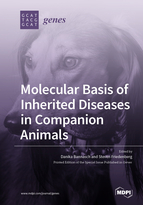Molecular Basis of Inherited Diseases in Companion Animals
A special issue of Genes (ISSN 2073-4425). This special issue belongs to the section "Animal Genetics and Genomics".
Deadline for manuscript submissions: closed (30 September 2020) | Viewed by 72573
Special Issue Editors
Interests: canine genetics and genomics; molecular basis of inherited disease in dogs and horses; canine morphology; genetic counseling
Special Issue Information
Dear Colleagues,
The field of companion animal genetics has evolved rapidly since the publication of the dog genome in 2005 and the cat genome in 2007. Over the past 15 years, our community has made major advances in understanding the genetic basis of many inherited diseases in companion animals. These discoveries have helped eliminate or significantly reduce the incidence of many life-limiting conditions in our pets, and also demonstrated the importance of companion animal diseases as models for similar disorders in humans. Many early discoveries in our field involved simple Mendelian conditions, but more recent work has started to make strides in understanding the genetic basis of complex inherited disorders.
In this Special Issue, we welcome reviews, original articles, and short communications covering all areas related to the genetic and molecular basis of inherited disorders in dogs, cats, horses, and other companion animal species. These include, but are not limited to, manuscripts related to germline genetics, transcriptomics, and epigenetics. In particular, we are seeking manuscripts that demonstrate the molecular effects of genes and genetic variation on the pathogenesis of companion animal diseases. We are also seeking manuscripts related to improving our understanding of complex inherited disorders in companion animals.
We look forward to your contributions. Please feel free to contact either of us if you have any questions about the guidelines or requirements for this Special Issue.
Dr. Danika Bannasch
Dr. Steven Friedenberg
Guest Editors
Manuscript Submission Information
Manuscripts should be submitted online at www.mdpi.com by registering and logging in to this website. Once you are registered, click here to go to the submission form. Manuscripts can be submitted until the deadline. All submissions that pass pre-check are peer-reviewed. Accepted papers will be published continuously in the journal (as soon as accepted) and will be listed together on the special issue website. Research articles, review articles as well as short communications are invited. For planned papers, a title and short abstract (about 100 words) can be sent to the Editorial Office for announcement on this website.
Submitted manuscripts should not have been published previously, nor be under consideration for publication elsewhere (except conference proceedings papers). All manuscripts are thoroughly refereed through a single-blind peer-review process. A guide for authors and other relevant information for submission of manuscripts is available on the Instructions for Authors page. Genes is an international peer-reviewed open access monthly journal published by MDPI.
Please visit the Instructions for Authors page before submitting a manuscript. The Article Processing Charge (APC) for publication in this open access journal is 2600 CHF (Swiss Francs). Submitted papers should be well formatted and use good English. Authors may use MDPI's English editing service prior to publication or during author revisions.
Keywords
- Companion animals
- Dogs
- Cats
- Horses
- Genetics
- Genomics
- Epigenetics
- Mendelian traits
- Complex traits
- Animal models of disease







